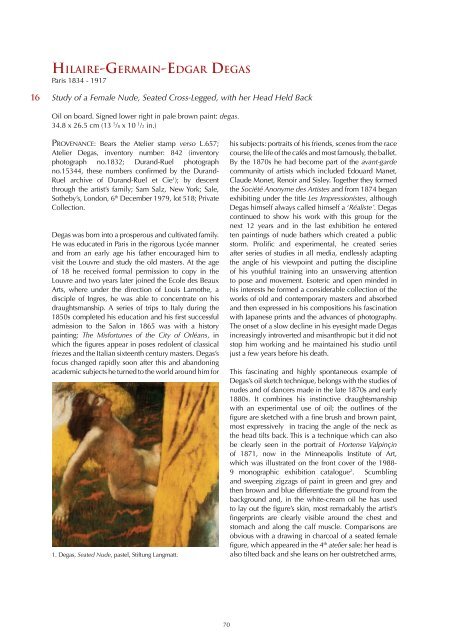Create successful ePaper yourself
Turn your PDF publications into a flip-book with our unique Google optimized e-Paper software.
Hilaire-Germain-Edgar Degas<br />
Paris 1834 - 1917<br />
16<br />
Study of a Female Nude, Seated Cross-Legged, with her Head Held Back<br />
Oil on board. Signed lower right in pale brown paint: degas.<br />
34.8 x 26.5 cm (13 5 /8 x 10 1 /2 in.)<br />
Provenance: Bears the Atelier stamp verso L.657;<br />
Atelier Degas, inventory number: 842 (inventory<br />
photograph no.1832; Durand-Ruel photograph<br />
no.15344, these numbers confirmed by the Durand-<br />
Ruel archive of Durand-Ruel et Cie 1 ); by descent<br />
through the artist’s family; Sam Salz, New York; Sale,<br />
Sotheby’s, London, 6 th December 1979, lot 518; Private<br />
Collection.<br />
Degas was born into a prosperous and cultivated family.<br />
He was educated in Paris in the rigorous Lycée manner<br />
and from an early age his father encouraged him to<br />
visit the Louvre and study the old masters. At the age<br />
of 18 he received formal permission to copy in the<br />
Louvre and two years later joined the Ecole des Beaux<br />
Arts, where under the direction of Louis Lamothe, a<br />
disciple of Ingres, he was able to concentrate on his<br />
draughtsmanship. A series of trips to Italy during the<br />
1850s completed his education and his first successful<br />
admission to the Salon in 1865 was with a history<br />
painting: The Misfortunes of the City of Orléans, in<br />
which the figures appear in poses redolent of classical<br />
friezes and the Italian sixteenth century masters. Degas’s<br />
focus changed rapidly soon after this and abandoning<br />
academic subjects he turned to the world around him for<br />
1. Degas, Seated Nude, pastel, Stiftung Langmatt.<br />
his subjects: portraits of his friends, scenes from the race<br />
course, the life of the cafés and most famously, the ballet.<br />
By the 1870s he had become part of the avant-garde<br />
community of artists which included Edouard Manet,<br />
Claude Monet, Renoir and Sisley. Together they formed<br />
the Société Anonyme des Artistes and from 1874 began<br />
exhibiting under the title Les Impressionistes, although<br />
Degas himself always called himself a ‘Réaliste’. Degas<br />
continued to show his work with this group for the<br />
next 12 years and in the last exhibition he entered<br />
ten paintings of nude bathers which created a public<br />
storm. Prolific and experimental, he created series<br />
after series of studies in all media, endlessly adapting<br />
the angle of his viewpoint and putting the discipline<br />
of his youthful training into an unswerving attention<br />
to pose and movement. Esoteric and open minded in<br />
his interests he formed a considerable collection of the<br />
works of old and contemporary masters and absorbed<br />
and then expressed in his compositions his fascination<br />
with Japanese prints and the advances of photography.<br />
The onset of a slow decline in his eyesight made Degas<br />
increasingly introverted and misanthropic but it did not<br />
stop him working and he maintained his studio until<br />
just a few years before his death.<br />
This fascinating and highly spontaneous example of<br />
Degas’s oil sketch technique, belongs with the studies of<br />
nudes and of dancers made in the late 1870s and early<br />
1880s. It combines his instinctive draughtsmanship<br />
with an experimental use of oil; the outlines of the<br />
figure are sketched with a fine brush and brown paint,<br />
most expressively in tracing the angle of the neck as<br />
the head tilts back. This is a technique which can also<br />
be clearly seen in the portrait of Hortense Valpinçin<br />
of 1871, now in the Minneapolis Institute of Art,<br />
which was illustrated on the front cover of the 1988-<br />
9 monographic exhibition catalogue 2 . Scumbling<br />
and sweeping zigzags of paint in green and grey and<br />
then brown and blue differentiate the ground from the<br />
background and, in the white-cream oil he has used<br />
to lay out the figure’s skin, most remarkably the artist’s<br />
fingerprints are clearly visible around the chest and<br />
stomach and along the calf muscle. Comparisons are<br />
obvious with a drawing in charcoal of a seated female<br />
figure, which appeared in the 4 th atelier sale: her head is<br />
also tilted back and she leans on her outstretched arms,<br />
70
















